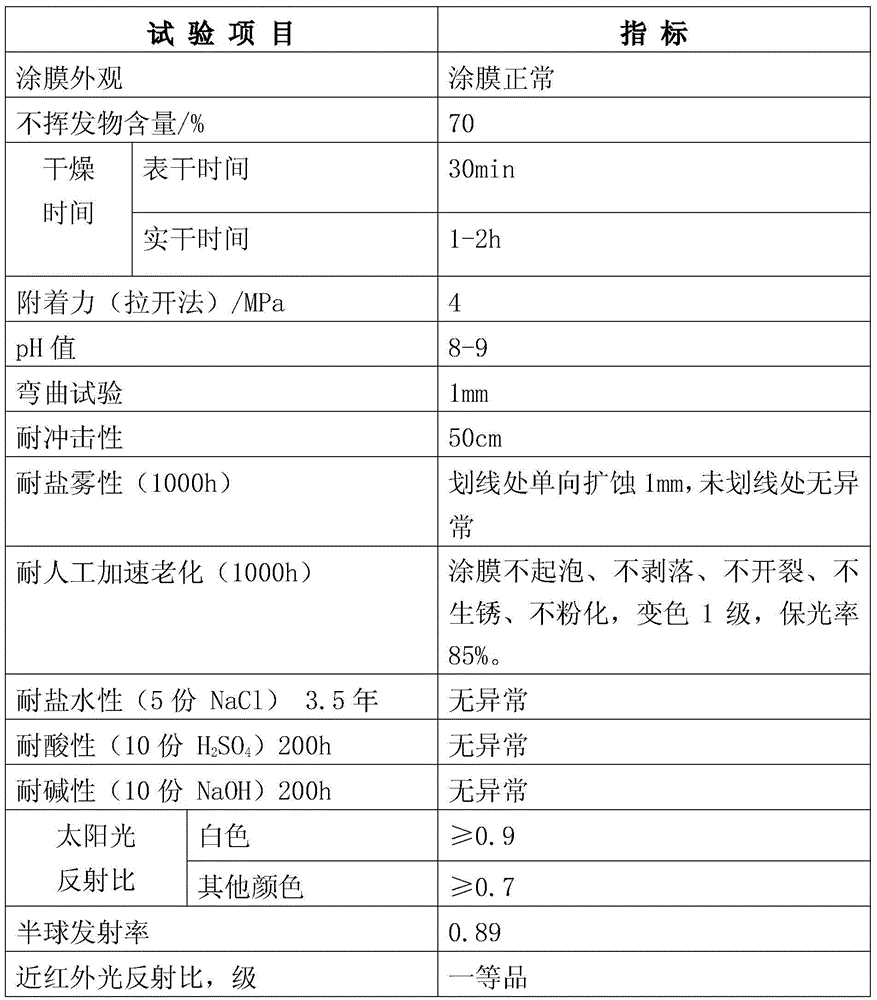Heat-reflection thermal insulation anti-corrosion coating and preparation method thereof
An anti-corrosion coating and heat reflection technology, applied in anti-corrosion coatings, reflective/signal coatings, coatings, etc., can solve the problems of insufficient adhesion of the base surface, low solar heat reflectivity, high thermal conductivity, etc., to improve adhesion , Strong ability to absorb ultraviolet rays, good thermal stability
- Summary
- Abstract
- Description
- Claims
- Application Information
AI Technical Summary
Problems solved by technology
Method used
Image
Examples
Example Embodiment
[0035] Example 1
[0036] The synthesis process of nano zinc oxide powder is as follows:
[0037] Weigh a certain amount of Na 2 CO 3 Dissolve in deionized water to make 1mol / L Na 2 CO 3 Solution. Add a 2% mole fraction of surfactant sodium dodecylbenzene sulfonate solution and place it on a magnetic stirrer to stir. After the solution is evenly mixed, the Na 2 CO 3 The solution was added dropwise to the 1mol / L Zn(NO 3 ) 2 In the solution, continue to stir and mature for 15 minutes after the dropping, and the basic zinc carbonate obtained by the reaction is the precursor of nano zinc oxide. Then the nano-zinc oxide precursor is washed, first with deionized water, and then with acetone. Then suction filter. Then put it in an oven to dry at 110 degrees Celsius. The fully dried precursor is firstly ground in a mortar, and then calcined in a muffle furnace at a temperature of 400 degrees Celsius for 2 hours, and finally the product is ground to obtain nano zinc oxide powder.
[0038...
Example Embodiment
[0039] Example 2
[0040] The synthesis process of nano zinc silicate hollow spheres is as follows:
[0041] Add 1ml of 0.2mol / L zinc nitrate solution and 1ml of 0.2mol / L sodium silicate solution to the mixed solution of 30ml ethanol and 3ml polyethylene glycol successively, then add 0.1ml4mol / L NaOH solution and magnetically stir for 15min, then transfer to 40ml hydrothermal kettle, react for 12h under hydrothermal conditions at 190°C. After the reaction is completed, the hydrothermal kettle is naturally cooled, the precipitate is collected by centrifugation, and washed with distilled water and ethanol respectively to remove possible impurity ions, and then the sample is vacuum dried in a vacuum oven at 60 degrees Celsius for 4 hours.
[0042] The obtained sample structure is a hollow structure, the outer diameter of the hollow sphere is between 50-200 nm, and the wall thickness is 20 nm.
Example Embodiment
[0043] Example 3
[0044] The components of the heat-reflective insulation and anti-corrosion coating are as follows:
[0045] The raw material components of a heat-reflective heat-insulating anti-corrosion coating are as follows: acrylic emulsion 30, hollow ceramic beads 10, titanium dioxide 6, talc 4, precipitated barium sulfate 2, nano zinc oxide 3, nano silicon Zinc acid 3, silane coupling agent KH-550: 6, dispersant BYK-111: 1.8, waterproofing agent sodium methyl silicate 4, PH value regulator AMP-95: 0.5, water-based paint defoamer JY-821: 2. Alkali-soluble thickener ASE-60: 0.2, advection agent w491: 0.3, film forming aid TEXANOL1321: 2, deionized water 25.
PUM
| Property | Measurement | Unit |
|---|---|---|
| Diameter | aaaaa | aaaaa |
| Outer diameter | aaaaa | aaaaa |
Abstract
Description
Claims
Application Information
 Login to View More
Login to View More - R&D
- Intellectual Property
- Life Sciences
- Materials
- Tech Scout
- Unparalleled Data Quality
- Higher Quality Content
- 60% Fewer Hallucinations
Browse by: Latest US Patents, China's latest patents, Technical Efficacy Thesaurus, Application Domain, Technology Topic, Popular Technical Reports.
© 2025 PatSnap. All rights reserved.Legal|Privacy policy|Modern Slavery Act Transparency Statement|Sitemap|About US| Contact US: help@patsnap.com

